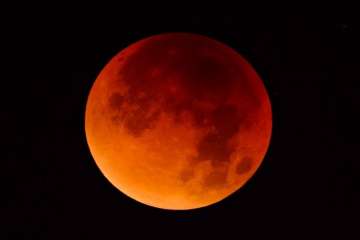Blood Moon 2018: India to witness LONGEST total lunar eclipse on July 27- Here's all you need to know
The blood moon on July 27 is likely to last for more than 100 minutes and is expected to cast a larger shadow over the Earth than previously recorded moons.

People across the world are eagerly waiting for July 27, to witness the marvellous celestial phenomena of the Blood Moon 2018. The phenomenon is going to be the longest total lunar eclipse of the 21st century.
The July 27 blood moon is likely to last beyond 100 minutes and is expected to cast a larger shadow over the Earth than previously recorded moons. This is because on July 27, the Earth will be at its farthest distance from the Sun, and the Moon will also be at its greatest distance from the Earth.This year's blood moon will also see the Moon cast in a crimson red hue for the duration of the eclipse. The blood moon is expected to be visible in India, as well as many parts of Europe, Africa, Asia, Australia and New Zealand.
1. WHAT IS A BLOOD MOON?
Blood Moon occurs when the moon glows a deep red colour due to sunlight scattering. As there is no direct sunlight hitting the moon during an eclipse, all of the light which reaches the moon and bounces back to Earth is indirect. The indirect light goes through Rayleigh scattering as it passes through Earth's atmosphere. This, in effect, scatters the longer blue and violet wavelengths more than the shorter red and orange wavelengths. Hence, more red/orange wavelength light reaches the moon and is bounced back to Earth, presenting to us a deep red blood moon. Another unique factor about this year's total lunar eclipse is that the Earth is close to the farthest it will be from the Sun.The reason this lunar eclipse is the longest of the 21st century is because it passes through the center of Earth's shadow, increasing the time in which the moon is blocked from the sun.
2. AT WHAT TIME THE TOTAL LUNAR ECLIPSE WILL BE SEEN?
The total lunar eclipse will reach its peak sometime around 8:22 p.m. UTC or Coordinated Universal Time, which equates to 1:52 am (IST-Indian Standard Time). This translates to roughly 4:22 p.m. EDT or Eastern Daylight Time.
ALSO READ| Blood Moon 2018: Details on the century’s longest total lunar eclipse
Unfortunately, most residents of North America will have to settle for a high-definition video of the eclipse as it occurs, while those in the European Union and neighboring areas may have a bit more luck to view the extremely rare astronomical event with the naked eye.
3. HOW LONG WILL THE TOTAL LUNAR ECLIPSE LAST?
The total lunar eclipse, also featuring the Blood Moon, will last for a whopping one hour and 43 minutes. This also outstrips the Super Blue Blood Moon combination that occurred in January of this year by nearly three-quarters of an hour.
4. WHEN AND WHERE TO WATCH?
The Blood Moon 2018 will majorly be seen in the Eastern Hemisphere including Central Asia and Eastern Africa. While skywatches in India will be able to see the initial stages of the Blood Moon 2018 on July 27, the particular stage is known as the Penumbral phase. The Blood Moon 2018 will be first visible in India from around 10:44pm IST while its capital New Delhi could be right between the action of the full total eclipse at around 1 am IST on Saturday, July 28 which will end at 2.43am IST. Moreover, in July 2018, the full moon, as well as the lunar apogee fall, are occurring on the exact same date, which is July 27 and lunar apogee is said to be the moon’s farthest orbital point from the Earth, which makes it appear particularly small and distant.
Lunar Eclipse 2018: Timings to watch the first phase in India
The first part of the lunar eclipse will see the Moon fall under the Earth’s shadow. This part of the eclipse is known as the penumbral eclipse, as the Moon is under partial influence of the shadow cast by the Earth also called Umbra. Scientists predict that this event could begin from 11.44 pm IST on July 27.
As this happens, some part of the Moon will not be visible to stargazers, resulting in a partial lunar eclipse. The first phase of this partial lunar eclipse is expected to set in from 11.54 pm. This eclipse is represented as phase one of the partial eclipse, since a second partial eclipse will be witnessed after the total lunar eclipse ends.
Total Lunar Eclipse: Timings to watch
The most-awaited phase of the eclipse, the total lunar eclipse, is estimated to set in from 1 am IST on July 28. It should be visible in Indian cities like Delhi, Pune, Mumbai, etc, but the weather forecast will end up playing a role in this. Cloudy skies could play spoilsport for those who are interested in watching the total lunar eclipse.
For the duration of the total lunar eclipse, the Moon will be completely engulfed by the Earth’s shadow. The Moon will get to the height of the eclipse at around 1.51 am, at which point it would have reached the centre of the Umbra. This will persist until 2.43 am, after which the Moon will begin to move outside the Earth’s shadow. The total lunar eclipse will last nearly 103 minutes, which makes it the century’s longest.
Lunar Eclipse 2018: Phase II, When to watch in India
As the Moon continues on its orbit, and pulls away from the Umbra, stargazers will notice another partial lunar eclipse. This will pick up from around 2.43 am IST, which will then be followed by another penumbral eclipse. While the partial lunar eclipse is expected to end by 3.49 am, and the penumbral eclipse would end by about 4.58 am.